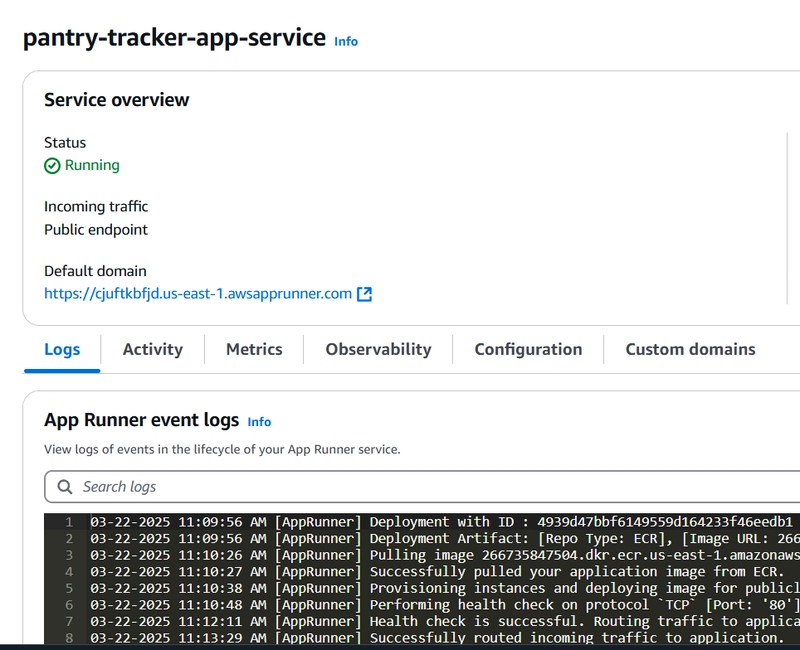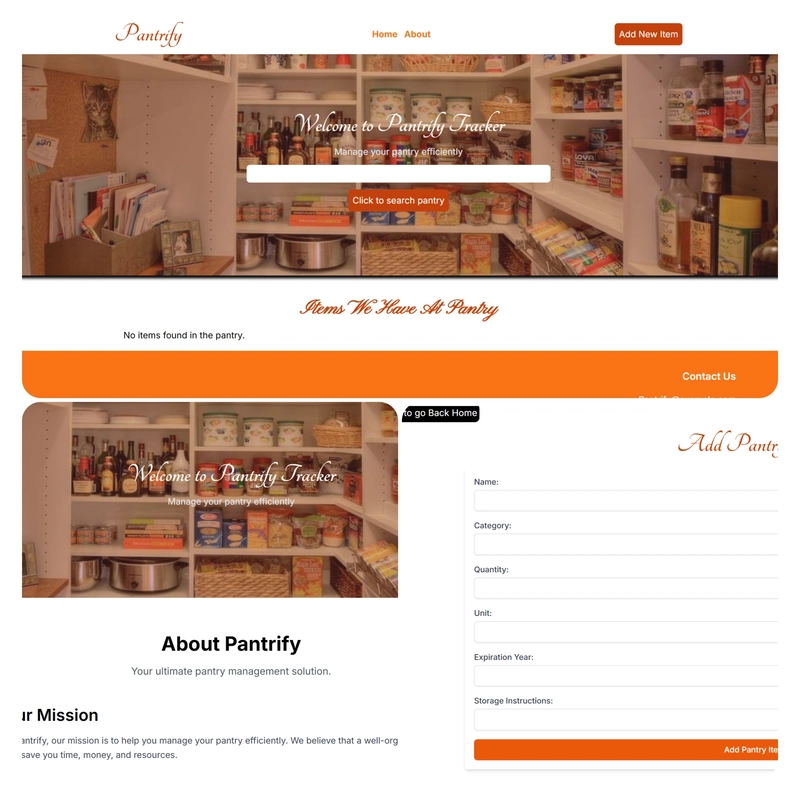Deploying an App With AWS App Runner
Deploying applications can be a hassle, especially when managing servers and infrastructure. That's where AWS App Runner comes in! In this article, I'll walk you through how I deployed my Pantry Tracker App using Docker and AWS App Runner, making the entire process seamless. Prerequisites Node.js Docker VsCode (IDE) Next.js Tailwind CSS Firebase Console Why Use AWS App Runner? AWS App Runner is a fully managed service that makes it easy to deploy containerized applications without worrying about server management. Here’s why I chose it: Infrastructure management: No need to provision or maintain servers. Scalability: It automatically scales based on demand. Fast deployment: Just push your container image, and App Runner takes care of the rest. Load Balancing: Built-in load balancing handles traffic efficiently without extra configurations. Why Dockerize Your App? Before deploying, I Dockerized my Next.js-based Pantry Tracker App. Why? Portability: Works the same in any environment. Consistency: Avoids the "works on my machine" problem. Easy deployment: Package the app with its dependencies in one container. Setting Up the Project Technologies Used Frontend: Next.js, React, Tailwind CSS. Backend: Firebase (Firestore for database). Deployment: AWS App Runner, AWS Elastic Container Registry (for container image repository), Docker. Before starting, make sure you have: Node.js Docker VsCode (IDE) Clone the Repository git clone https://github.com/ijayhub/pantry-tracker-app.git cd pantry-tracker-app Install Dependencies npm install Run the Application Locally npm start The app will be available at http://localhost:3000/. Docker Setup To containerize the application for deployment: Create a Dockerfile FROM node:18-alpine WORKDIR /app COPY package.json package-lock.json ./ RUN npm install COPY . . EXPOSE 3000 CMD ["npm", "run", "start"] Build and Run the Docker Container docker build -t pantry-tracker-app . docker run -p 3000:3000 pantry-tracker-app 1. Push Docker Image to AWS Elastic Container Registry (ECR) AWS App Runner pulls images from ECR, so we need to push our Docker image there. Push Docker Image to AWS Elastic Container Registry (ECR) aws ecr create-repository --repository-name pantry-tracker-app aws ecr get-login-password --region | docker login --username AWS --password-stdin .dkr.ecr..amazonaws.com docker tag pantry-tracker-app:latest .dkr.ecr..amazonaws.com/pantry-tracker-app:latest docker push .dkr.ecr..amazonaws.com/pantry-tracker-app:latest 2. Deploy to AWS App Runner Go to the AWS App Runner Console. Create a new service and select Container Registry. Choose your ECR repository and select the latest image. Configure environment variables and deployment settings. Click Deploy and let App Runner handle the rest! The visual output Conclusion Using AWS App Runner, I deployed my Pantry Tracker App without managing servers or dealing with complex configurations. By Dockerizing the app, I ensured consistency and portability, making deployment smooth and hassle-free. If you're looking for an easy way to deploy your applications, Docker + AWS App Runner is the way to go! You can find the Git repository here: pantry-tracker-app If you found this article helpful, share it with others who may find it interesting. Stay updated with my projects by following me on Twitter, LinkedIn, and GitHub. Thank you for reading.

Deploying applications can be a hassle, especially when managing servers and infrastructure. That's where AWS App Runner comes in! In this article, I'll walk you through how I deployed my Pantry Tracker App using Docker and AWS App Runner, making the entire process seamless.
Prerequisites
VsCode (IDE)
Why Use AWS App Runner?
AWS App Runner is a fully managed service that makes it easy to deploy containerized applications without worrying about server management. Here’s why I chose it:
Infrastructure management: No need to provision or maintain servers.
Scalability: It automatically scales based on demand.
Fast deployment: Just push your container image, and App Runner takes care of the rest.
Load Balancing: Built-in load balancing handles traffic efficiently without extra configurations.
Why Dockerize Your App?
Before deploying, I Dockerized my Next.js-based Pantry Tracker App. Why?
Portability: Works the same in any environment.
Consistency: Avoids the "works on my machine" problem.
Easy deployment: Package the app with its dependencies in one container.
Setting Up the Project
Technologies Used
Frontend: Next.js, React, Tailwind CSS.
Backend: Firebase (Firestore for database).
Deployment: AWS App Runner, AWS Elastic Container Registry (for container image repository), Docker.
Before starting, make sure you have:
Clone the Repository
git clone https://github.com/ijayhub/pantry-tracker-app.git
cd pantry-tracker-app
Install Dependencies
npm install
Run the Application Locally
npm start
The app will be available at http://localhost:3000/.
Docker Setup
To containerize the application for deployment:
Create a Dockerfile
FROM node:18-alpine
WORKDIR /app
COPY package.json package-lock.json ./
RUN npm install
COPY . .
EXPOSE 3000
CMD ["npm", "run", "start"]
Build and Run the Docker Container
docker build -t pantry-tracker-app .
docker run -p 3000:3000 pantry-tracker-app
1. Push Docker Image to AWS Elastic Container Registry (ECR)
AWS App Runner pulls images from ECR, so we need to push our Docker image there.
Push Docker Image to AWS Elastic Container Registry (ECR)
aws ecr create-repository --repository-name pantry-tracker-app
aws ecr get-login-password --region | docker login --username AWS --password-stdin .dkr.ecr..amazonaws.com
docker tag pantry-tracker-app:latest .dkr.ecr..amazonaws.com/pantry-tracker-app:latest
docker push .dkr.ecr..amazonaws.com/pantry-tracker-app:latest
2. Deploy to AWS App Runner
Go to the AWS App Runner Console.
Create a new service and select Container Registry.
Choose your ECR repository and select the latest image.
Configure environment variables and deployment settings.
Click Deploy and let App Runner handle the rest!
The visual output
Conclusion
Using AWS App Runner, I deployed my Pantry Tracker App without managing servers or dealing with complex configurations. By Dockerizing the app, I ensured consistency and portability, making deployment smooth and hassle-free.
If you're looking for an easy way to deploy your applications, Docker + AWS App Runner is the way to go!
You can find the Git repository here: pantry-tracker-app
If you found this article helpful, share it with others who may find it interesting.
Stay updated with my projects by following me on Twitter, LinkedIn, and GitHub.
Thank you for reading.












































































































































































![[The AI Show Episode 142]: ChatGPT’s New Image Generator, Studio Ghibli Craze and Backlash, Gemini 2.5, OpenAI Academy, 4o Updates, Vibe Marketing & xAI Acquires X](https://www.marketingaiinstitute.com/hubfs/ep%20142%20cover.png)




























































































































![[DEALS] The Premium Learn to Code Certification Bundle (97% off) & Other Deals Up To 98% Off – Offers End Soon!](https://www.javacodegeeks.com/wp-content/uploads/2012/12/jcg-logo.jpg)

![From drop-out to software architect with Jason Lengstorf [Podcast #167]](https://cdn.hashnode.com/res/hashnode/image/upload/v1743796461357/f3d19cd7-e6f5-4d7c-8bfc-eb974bc8da68.png?#)








































































































.png?#)


































_Christophe_Coat_Alamy.jpg?#)


.webp?#)





































































































![Apple Considers Delaying Smart Home Hub Until 2026 [Gurman]](https://www.iclarified.com/images/news/96946/96946/96946-640.jpg)
![iPhone 17 Pro Won't Feature Two-Toned Back [Gurman]](https://www.iclarified.com/images/news/96944/96944/96944-640.jpg)
![Tariffs Threaten Apple's $999 iPhone Price Point in the U.S. [Gurman]](https://www.iclarified.com/images/news/96943/96943/96943-640.jpg)






































































































































